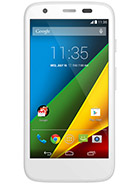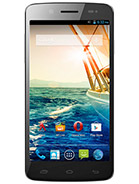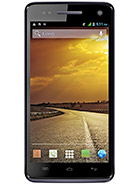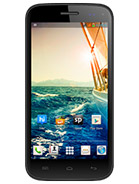Moto G (2014)
Moto G second generation


Introduction
As a successor to the most successful smartphone in Motorola's history, the second generation Moto G surely has hefty expectations to meet. A year after the XT1032 redefined the budget smartphone category by combining high-res screen, quality hardware, and up to date Android build, the newcomer aims to build on its success.
In line with the trends in the smartphone world, the new Moto G boasts a significantly larger display than the model it replaces, as well as beefed up camera. We also get a microSD card slot for cheap memory expansion and front-facing stereo speakers - their presence is hardly believable considering the unchanged starting price tag of the device.
New features aside, the 2014 Moto G offers similar hardware to the model it replaces. Take a look at it in our traditional list of key features below.
Key features
- Quad-band GSM/EDGE/HSDPA
- Available in dual-SIM variant
- 5" IPS 720p capacitive touchscreen of 294ppi, Gorilla Glass 3
- Android 4.4.4 KitKat and a fast track update program
- 1.2GHz quad-core Cortex-A7 CPU; 1GB of RAM; Adreno 305 GPU; Qualcomm Snapdragon 400 chipset
- 8MP camera, LED flash, 720p video capture, 2MP front-facing camera
- 8GB or 16GB of built-in memory, expandable via microSD card slot
- Active noise cancellation with a dedicated microphone
- FM radio
- 2,070mAh battery
- Optional battery covers in various colors
Main disadvantages
- No LTE connectivity at launch
- Hardware could have used a bump, especially in terms of available RAM
- Battery size has remained unchanged despite the larger display
- Camera doesn't record 1080p video
The presence or a larger display in the new Moto G is surely going to be a welcome sight for many users who can't stretch their budget towards a 5" flagship. Coupled with the stereo speakers and the microSD card slot, the quality IPS screen truly transforms the new model into a wallet-friendly multimedia powerhouse.
With stock Android 4.4.4 dressed in Google Now launcher, the 2014 Moto G delivers a true Nexus experience with a few nice extras on top. Timely update to Android L is promised as well.
The chipset surely could have used a refresh in the second generation, though Motorola has decided to focus on improving other areas and it obviously ran out of budget for a beefier SoC. Also, to be fair, despite being a year old, the Qualcomm Snapdragon 400 silicon is still a popular option in its segment - so maybe Motorola can get away with it for another cycle.
Our main concern about the new Moto G has to do with its battery. The non-removable 2,070mAh unit has been carried over from the first generation, yet it has a larger display to power up now, which may turn an average performance into a disappointing one.
Increased competition is another factor the 2014 Moto G has to face. A year after its predecessor caught the industry by surprise, entry-level and lower mid-range smartphone segments have emerged as the next major battlefield.
Does the new Moto G have what it takes to stay on top of its class? Read on to find out! As always, we will kick off our review with an unboxing, followed by a design and hardware inspection.
Editorial: You may notice that this review is shorter than usual and doesn't include some of our proprietary tests. The reason is it has been prepared and written away from our test labs. Still, we think we've captured the essence of the device in the same precise, informative and detailed way that's become our trademark. Enjoy the good read!
Design and build quality
Moto G (2014) has retained the design of the model it replaces. The only major difference between the first and the second generation are the gray strips above and below the newcomer's display, which house the stereo speakers.
The above considered, the Moto G is a decent looking bloke. The interchangeable back panels allow you to change the device's appearance and have it your way - from understated like the unit we tested, all the way to impossible to miss color combinations.
Build quality of the Moto G is exceptional, especially considering the price range it inhabits. The device is made of high-quality polycarbonate with matte finish, while its front is entirely covered by Corning Gorilla Glass 3. Its body is splash resistant too, though it is not IP certified.
Physical measures of the new Moto G are 141.5 x 70.7 x 11 mm and it tips the scale at 149 grams. As expected, the second generation has grown significantly over its predecessor (129.9 x 65.9 x 11.6 mm).
Thickness of the new Moto G is slight letdown, especially considering the unchanged battery size over last year's model. However, the presence of dual stereo speakers does somewhat make up for the substantial waistline.
Handling
Despite the thicker profile, handling of the new Moto G is easy thanks to its curved back. The latter follows the natural shape of the human palm and offsets the noticeable thickness of the phone.
The soft-touch plastic body of the smartphone enhances grip. You are unlikely to accidentally drop it.
Display
Moto G (2014) packs a 5" IPS display with a resolution of 1280 x 720 pixels. The display has grown in size over last year's model, but has retained the same resolution. The result is a lower, but still near-Retina pixel density of 294 ppi.

The display of the Moto G (2014) is a quality unit, despite the lower sharpness over last year's solution. It impresses with good color reproduction, stellar contrast, and wide viewing angles.
Compared to the 2013 model, however, the Moto G (2014) display is noticeably darker.
| Display test | 50% brightness | 100% brightness | ||||
| Black, cd/m2 | White, cd/m2 | Black, cd/m2 | White, cd/m2 | |||
| 0.42 | 387 | 916 | 0.7 | 651 | 929 | |
| 0.24 | 253 | 1039 | 0.43 | 413 | 968 | |
| 0.33 | 325 | 989 | 0.64 | 643 | 1000 | |
| 0.25 | 194 | 785 | 0.56 | 426 | 756 | |
| 0.17 | 207 | 1230 | 0.61 | 740 | 1213 | |
| 0.1 | 149 | 1522 | 0.45 | 667 | 1495 | |
Sunlight legibility is good, especially considering the price range the smartphone inhabits. It is not as reflective as one would expect.
Sunlight contrast ratio
- Nokia 808 PureView4.698
- Oppo Find 7a2.279
- Alcatel One Touch Hero2.272
- Apple iPhone 4S2.269
- HTC Desire 600 dual sim2.262
- Nokia Asha 3112.25
- Motorola Moto G (2014)2.233
- LG Nexus 52.228
- Nokia Lumia 8202.193
- HTC One (E8)2.185
- Oppo N32.181
- Nokia Lumia 9202.17
- Samsung Galaxy mini 21.114
Overall, despite its lower pixel density when compared to last year's model, the display of the new Moto G is one of the best in its class. You will be hard-pressed to find a better screen on a sub-$200 smartphone.
Final words
Moto G (2014), like its predecessor, is easily among the most capable Android smartphones you can buy in its price range. The smartphone offers a well-designed, solidly crafted hardware package, topped with up-to-date OS, which is bound to receive updates in a timely fashion.

"Don't change it unless you can make it better" is the mantra, which Motorola embraced during the development of the new Moto G. In this regard, the manufacturer deserves credit for updated features without changing the entry-level price of the smartphone.
Key review findings
- Build quality and overall ergonomics of the smartphone are good
- The display is a high quality unit despite its lower pixel density; it's darker than the screen of the previous Moto G though
- The stereo speakers are a great addition to the list of features, but quieter than the single speaker on the previous model
- Chipset and graphic performance are in line with similar devices
- More RAM on board would have been great
- 1080p video capture is a noticeable omission, still camera shows some improvements
- Average battery life, web browsing time significantly decreased since the Moto G 4G
The larger display and the stereo speakers help the device stand out among its competitors. We are really pleased that Motorola brought enhanced audio experience to the Moto G - it is truly hard to come by in its segment.
With the addition of a microSD card slot on the other hand, Motorola addressed one of the biggest shortcoming the first Moto G had. Cheap memory expansion is vital in the markets where the 2014 Moto G will aim to succeed - we reckon that the memory slot alone will help it win quite a few new fans.
Stock Android 4.4.4 and the promise of timely update to the next major OS build are another major plus for the new Moto G. Budget smartphones rarely get treated this well - actually few of them are even on sale with the latest Android version at the moment.
The Snapdragon 400 chipset offers performance that is on par with standard for this segment. It's not ground breaking anymore, but adequate is good enough for a chipset clearly getting long in the tooth.
The lack of a larger battery is the biggest gripe we have with the new Moto G. Considering its expanded multimedia capabilities, we reckon that more mAh would have been great to have on board and given the thickness of the device we can't imagine it would have been too hard to fit.
Lack of 1080p video recording is another major omission, despite the brand new camera sensor in the new Moto G. We believe that the lack of additional RAM played a role on this instance.
However, all shortcomings that the new Moto G has are more than made up for by its price. At $179.99, the smartphone is an incredible value any way you look at it. Here are some alternatives in case you are willing to shop around.
Motorola's own Moto G 4G might technically be a predecessor, but it's actually an alternative to the 2014 model. It offers more compact body with LTE connectivity and microSD card slot, though it is a tad more expensive at $219.
Xiaomi Redmi 1S matches closely the new Moto G in specs and is even cheaper than the subject of our review. However, it runs an outdated Android version and is incredibly hard to find in stores outside China.
Sony Xperia E3 is an interesting alternative, though it lags behind the new Moto G in terms of screen resolution and doesn't offer stereo speakers. Its pricing is yet to be known, though it will likely be in the same ballpark as the new Moto G.
Micromax Canvas Elanza 2, Canvas 2 Colors and Canvas Turbo Mini all offer 720p displays and run on quad-core Cortex-A7 processors. They are also dual-SIM-enabled and feature capable 8MP snappers. However, they lag behind the Moto in terms of Android build, brand appeal, as well as design and finish.
Buying a smartphone for less than $200 will always require certain levels of compromise. However, the Moto G (2014) balances things out well enough so none of those are deal-breakers and that's a big win in this segment. You will simply be hard-pressed to find a better new Android phone for the money.
Subscribe to:
Post Comments
(
Atom
)
































No comments :
Post a Comment